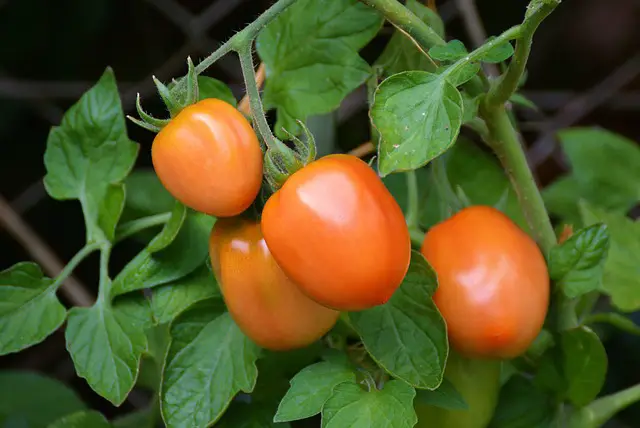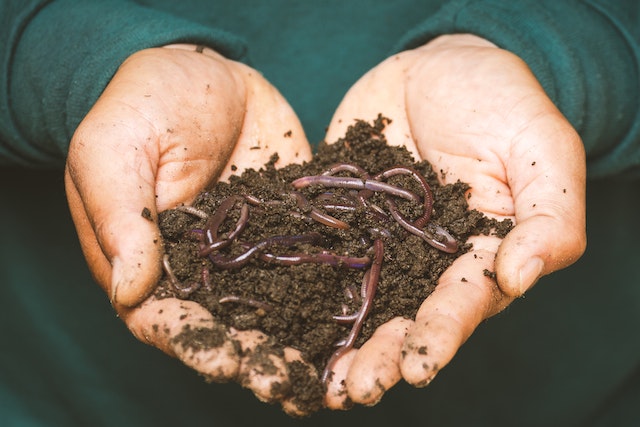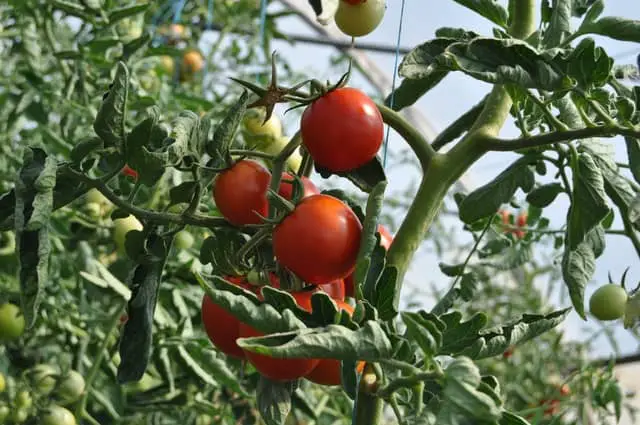Tomato plant leaves turning white is an indication that your crop isn’t receiving proper care and attention.
Tomatoes, one of the most commonly grown garden plants, are sensitive to cold and excess sunlight. Several people have begun planting tomatoes within their houses and transplanting them once the soil has thoroughly warmed up due to their exceptionally long growing season.
Many problems can occur during the transplantation of tomato seedlings. For instance, tomato plant leaves turning white. The sensitive nature of their leaves often makes them susceptible to white tomato leaves. Let’s explore more about tomato plant leaves turning white!
Tomato Plant Leaves Turning White

The most common cause of white leaves in tomatoes is exposure to intense sunlight, especially in young seedlings that have just been transplanted. Even though tomato plants require full sun for healthy growth, a sudden transition from indoors to outdoors may shock the plants and cause their leaves to turn white.
You may find that your tomato plants have silver or white leaves once they have been exposed to the sun, or more likely, they’re infected with a disease (most likely fungus).
On tomato plants, the damage from sunlight appears in a white border around the leaves. The leaves may curl and break, leaving the plant with minimal foliage. When tomato plants suffer from sunscald, their fruits appear blistered and papery. The transplantation area may also be affected by strong winds.
It is easy to solve the problem of tomatoes with white leaves caused due to overexposure in sunlight. One of the best ways to get your tomato transplant accustomed to intense sunlight is to languish it in the gray shade for a few days.
Gradually expose them to sunlight for a few hours per day for a couple of weeks. This hardens off different parts of the plant. Plants acclimate to more radical surroundings with either of these options. Place a windbreak around the transplants, or relocate them to a protected location if hot, dry winds are an additional concern.
In either case, the plant will likely recover unless the windburn or sun scorch is severe. Remove any affected leaves to prevent the plant from getting sick.
Chemical Damage
Regular exposure to chemicals, including pesticides and herbicides, can cause leaf discoloration in tomatoes. Usually, chemical damage in plants causes bleaching in their leaves, also known as leaf chlorosis.
Chlorophyll plays a major role in photosynthesis, the process by which plants convert light into energy. It is also responsible for the green color of healthy leaves. If a plant is suffering from chemical damage, the enzymes involved in the production of chlorophyll may not function properly. When this happens, the plant will produce pale green or white-coloured leaves.
Once you notice that your tomato leaves are turning white from chemical damage, stop applying more chemicals to the plant. Rinse the tomato leaves with water to remove chemical residue and keep monitoring their recovery.
Infestation of Pests
Spider mites are one of the most common pests that cause tomato leaves to turn white. They feast on tomato sap by extracting nutrients from the leaf cells. While feeding on the tomato leaves, spider mites destroy their tissues. As a result, they’ll prevent the free flow of water and nutrients to the tomato plants.
Spider mite attacks can cause tomato leaves to turn yellow or white. Other pests that cause leaf discoloration in tomatoes include thrips, aphids, and whiteflies. Apply neem oil or other pesticides to the plant leaves to control the spread of pests.
Fungi Cause White Leaves On Tomato Plants

White leaves on tomato plants can also be caused by disease, in addition to environmental exposure. Generally, the disease is fungal and occurs due to overwatering.
Rotten root, Alternaria, and Septoria leaf spots can occur when too much water is in the soil resulting in white blotches on leaves and dark borders. Water deeply once a week to twice a week for the first three days, depending on the climate.
A deep root system promotes root development and prevents fungal spores from growing. If a fungal disease has attacked the root of your tomato plants, try using a fungicide that’s specifically designed for use on tomato plants to repair any leaves that have turned white.
A Lack Of Nutrients Or An Excess Of Nutrients Could Be The Cause Of White Leaves In Tomatoes

In addition, your tomatoes could turn white due to a lack of nutrients. Yellowing or whitening of leaves may occur when plants lack nitrogen or phosphorus and poor fertilization of the soil. It also requires proper fertilization.
Most likely, tomato fertilizer that contains the right amount of these nutrients would be the solution. Furthermore, calcium and magnesium deficiency will cause the leaves to whiten, through the veins retain their green color.
The White Color Of Tomato Leaves
Plants with this problem are widespread. The leaves of your tomato plants can turn white for various reasons, so it’s critical to identify the cause and take steps to fix it.
Beware of placing tomato plants in scorching sunlight for more extended periods. Else, you will burn its sensitive leaves quickly. This condition is known as sunscald and can occur in tomato plants exposed to full sun all day. They will begin to develop pale yellow or white patches on their leaves, which you do not want to happen to your tomato plant.
Tomato plants tend to develop white patches on their leaves when temperatures are too cold outside their optimal range. The tomato plant’s reaction to cold temperatures closes its leaf cells. This will keep them warm and protect them if they are too far from a more courteous environment (such as a greenhouse or house).
The leaves of tomato plants that turn white when exposed to these colder temperatures can be severely damaged when left unprotected.
Sunscald In Tomatoes: Solutions
Sunlight damage often appears as a white border around the leaves of tomato plants because of the color of their leaves. Tomato foliage may also be curled or broken. Heavy winds aggravate the condition in the area.
The plant is most likely doomed if the leaves turn white and curl up as they age. The tomato plants affected by sunscald will not recover since it is not a disease of tomato plants.
If tomato plants are not affected by the disease, you can move them to a shadier location and remove the damaged leaves. You can also apply mulch or straw to the soil around sunscald tomato plants for added insulation and protection from harsh sunlight.
To treat tomato sunscald, some tomato growers recommend applying a general-purpose fertilizer to the soil surface around the affected tomato plants; this will help prevent further damage.
Learn more about tomato plant: Small Black Bugs On Tomato Plants
Summary
Now, clear about tomato plant leaves stunning white? Hoping that this blog post has provided you with some insight into why tomato leaves turn white, what might be causing it, and how to fix it!
In summary, white tomato leaves have a variety of causes, and this article has addressed a few common ones. Some of these problems can be solved by moving the plant away from direct sunlight, fertilizing the soil more often, or reducing the amount of water your plant receives.
Read more on plant care: How To Get Rid Of Grass In A Vegetable Garden
Frequently Asked Questions
What Is The Recommended Amount Of Water For Tomatoes?
Despite not requiring a ton of water, tomato plants require frequent watering. In the summer, tomato plants need to be watered more than when the temperature is more relaxed. They need at least one inch of water a week in the summer.
The root cause of many tomato plant problems, such as blossom end rot, is too much or too little water. Too little watering will usually result in tomatoes not growing well due to a dry environment or soil that requires amendments to support successful tomato growth.
Is It Possible To Cure Tomato Plants Of Nutrient Deficiencies?
If tomato plants become nutritionally deficient, they can recover by adding fertilizer designed for tomatoes to their soil and adding mulch if necessary.
Do Tomato Seedlings Need To Be Transplanted At A Particular Time?
The tomato prefers warm weather, as do other plants. It is, however, capable of surviving in a wide range of temperatures. When you live in a climate where winters are brief and excellent (or nonexistent), it is best to start seeds indoors and transplant them into the garden once all danger of frost has passed.

Hey, I’m Lisa and I’ve been an avid gardener for over 30 years. I love writing, talking and living in the garden! Feel free to connect with me on my socials below

